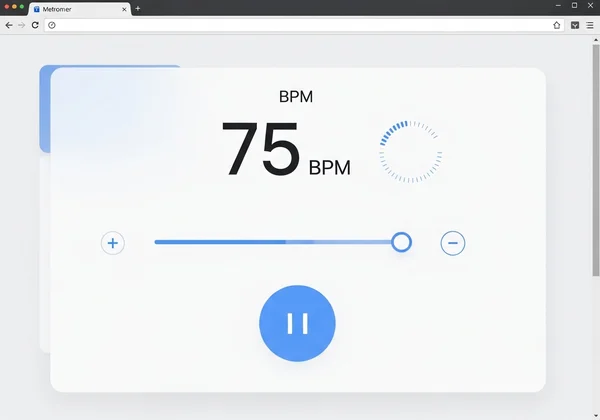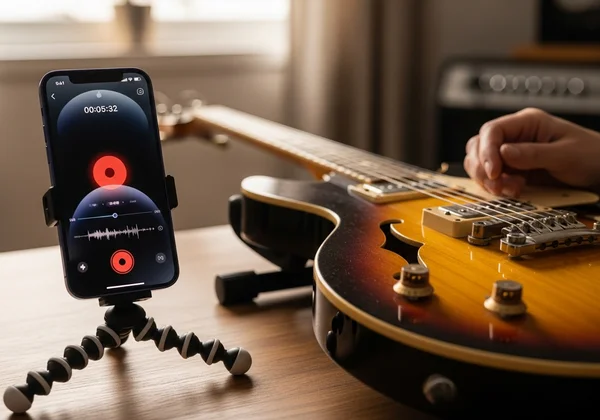Ultimate Guide: Free Online Metronome Practice & How to Use It Effectively
Every musician aims for impeccable rhythm—the unshakable foundation of great music. But developing that internal clock can be frustrating. If you've ever felt your tempo rush during an exciting solo or drag during a slow passage, you're not alone. The key lies in smarter metronome practice. But how can a metronome improve your playing in a natural, not robotic, way?
This guide is your complete roadmap. We will demystify the clicking companion that has shaped musicians for centuries. This guide will show you how to use a metronome online to transform your timing, speed, and confidence. Get ready to unlock your true rhythmic potential by visiting our tool at MetronomeOnline.org and following along.

Why Our Free Online Metronome is Essential for Every Musician
Let's solidify the "why." A metronome is more than a time-keeper; it's a personal rhythm coach providing unbiased feedback. Finding a reliable metronome online is crucial for consistent practice. This practice builds the essential skills separating amateurs from pros, acting as the secret ingredient for a polished performance.
Building a Rock-Solid Internal Clock and Timing
The ultimate goal is to internalize the beat so you eventually don't need a metronome. Its steady, relentless click trains your brain to recognize a consistent pulse, building a reliable internal clock. This allows you to maintain tempo without external help, which is crucial for playing confidently alone or with others.
Enhancing Speed, Accuracy, and Consistency in Your Playing
Have you ever tried to play a fast passage only to have it fall apart into a sloppy mess? A metronome is the perfect tool for building speed with precision. By starting slow and gradually increasing the tempo, you train your muscle memory to execute notes cleanly and accurately. This methodical approach ensures that your speed is built on a foundation of control, not chaos, leading to a more consistent and professional sound.
Unlocking Complex Rhythms and Challenging Time Signatures
Music is full of intricate rhythms and odd time signatures that can trip up even experienced players. A metronome helps you break these challenges down into manageable pieces. By setting it to click on subdivisions of the beat, you can pinpoint exactly where each note should land. This makes learning complex syncopation, polyrhythms, or a 7/8 groove feel less like guesswork and more like solving a satisfying puzzle.
Getting Started: Using a Metronome Online for Beginners
Feeling motivated? Great! Getting started is simple, especially with an intuitive tool. The key is to begin with the basics and build from there. Don't try to tackle your most difficult piece on day one. Instead, focus on building a comfortable and productive relationship with the beat.
Setting Your First Tempo (BPM) with Our Online Metronome
First, navigate to the online metronome tool. You'll see a clear interface with controls for Beats Per Minute (BPM). BPM simply means how many clicks you will hear in one minute. For your first session, choose a slow, comfortable tempo—something between 60 and 80 BPM is a great starting point. You can use the slider, the +/- buttons, or type the number directly. The goal is to play a simple scale or a few chords perfectly in time with the click.

Understanding Basic Time Signatures: 4/4, 3/4, and Beyond
The time signature tells you how many beats are in a measure. The most common is 4/4 (four beats per measure), which you'll find in most pop, rock, and electronic music. You can easily set this on our metronome. Try counting "1-2-3-4" along with the click. Then, explore 3/4 (think of a waltz: "1-2-3, 1-2-3"). Understanding this concept is fundamental to feeling the rhythmic pulse of any song.
Utilizing Visual and Auditory Cues for Enhanced Focus
A great online metronome provides more than just a click. On our online metronome, you’ll notice visual cues that pulse with the beat. This combination of sight and sound engages multiple senses, making it easier to lock into the groove. You can also customize the sound of the click and add an accent to the first beat of each measure, which helps you stay aware of the downbeat without getting lost.
Advanced Metronome Exercises & Techniques for All Levels
Once you're comfortable with the basics, it's time to explore some metronome exercises that will truly elevate your playing. These techniques are used by professional musicians to develop a deeper, more flexible sense of rhythm. They will challenge you to think beyond the click and truly internalize the beat.
Mastering Subdivisions: Feeling the Beat Within the Beat
The space between the clicks is just as important as the clicks themselves. Subdivisions are the smaller rhythmic values that exist within a beat (like eighth notes or sixteenth notes). Our tool allows you to select different subdivisions, providing clicks for these smaller notes. Practicing with eighth-note subdivisions (two notes per click) helps you play grooves with a steady, driving feel. This is essential for genres like rock, funk, and pop.
The "Silent Measures" Challenge for Developing Inner Rhythm
This exercise is a true test of your internal clock. Set the metronome to play for one measure and then be silent for the next. Your goal is to continue playing in perfect time during the silent measure and land precisely on the downbeat when the click returns. Start with one silent measure, and as you improve, try two or even three. It’s a powerful way to build rhythmic confidence.
Progressive Speed Training: Gradually Increasing Your BPM for Mastery
To master that blistering guitar solo or rapid piano arpeggio, you need a structured plan. Start at a BPM where you can play the passage perfectly. Once you can play it flawlessly several times in a row, increase the tempo by 2-4 BPM. Repeat this process until you reach your target speed. This gradual method of playing faster ensures your technique remains clean and controlled at every velocity.

Practicing with Accents, Polyrhythms, and Complex Time Signatures
Ready to push your boundaries? Use our metronome’s features to explore advanced concepts. You can set accents on different beats to practice syncopated rhythms against a steady pulse. By setting custom time signatures, you can tackle the progressive rock or modern jazz pieces you’ve always wanted to learn. The metronome provides the stable grid you need to confidently explore the most complex rhythmic territories.
Pro Tips: Maximizing Your Metronome Practice for Optimal Results
Integrating a metronome into your practice routine is one thing; maximizing its potential is another. These professional tips will help you get the most out of every session, turning practice from a chore into a period of focused, rapid growth.
Record Yourself: The Best Way to Identify Timing Issues
Your ears can sometimes deceive you in the moment. You might feel like you’re playing in time, but a recording provides the honest truth. Practice a piece with the metronome while recording yourself on your phone. When you listen back, you'll immediately hear where your timing tends to rush or drag. It's one of the fastest ways to diagnose and fix recurring rhythm problems.

Using Our Online Metronome's Tap Tempo for Song Analysis
Ever wondered about the exact tempo of your favorite song? Use the Tap Tempo feature on our website. Simply listen to the track and tap along to the beat, and the tool will calculate the BPM for you. This is an invaluable skill for learning songs by ear, figuring out drum machine patterns, or even finding the right tempo for your own creative ideas. It connects your practice directly to the music you love.
Make It Fun: Practice with Backing Tracks and Different Genres
Metronome practice doesn't have to be a sterile, robotic exercise. Once you've mastered a passage with a basic click, find a simple drum loop or backing track at the same BPM. You can start practicing now with a new feel. Practicing in a more musical context is more engaging and better prepares you for playing with other musicians. It’s the perfect way to apply your new, solid sense of time.
Your Journey to Rhythmic Mastery Starts Now
Ready to truly own your rhythm? Think of the metronome not just as a tool, but as your dedicated partner, guiding you as you master complex beats and unlock new levels of musical expression. From those first basic clicks to advanced rhythmic challenges, it's consistent practice that builds your inner clock and fuels your confidence. Don't let shaky timing hold you back. Your journey to impeccable rhythm is waiting, and our free online metronome is here to empower every step. Set your tempo, hit play, and transform your playing today!
Frequently Asked Questions About Metronome Practice
What is a good tempo for practice when using a metronome?
A good starting tempo is one where you can play a piece or exercise perfectly without feeling rushed. For many beginners, this is between 60 and 80 BPM. The golden rule is: if you're making mistakes, the tempo is too fast. Always prioritize accuracy over speed.
How can a metronome truly improve my playing and overall musicianship?
A metronome improves your playing by developing a precise internal sense of time, which is the foundation of all music. It enhances your accuracy, allows you to build speed methodically, helps you understand and execute complex rhythms, and makes you a more reliable musician to play with in a group setting.
Is a metronome only for beginners, or do professional musicians use it too?
Professionals use metronomes constantly! From warming up and learning new material to recording sessions in the studio, the metronome is an indispensable tool at every skill level. It helps them maintain objectivity and ensure their performance is rhythmically flawless.
How do I find the BPM of a song using our Tap Tempo feature?
It's easy! Go to our homepage and find the "Tap" button. Play the song you want to analyze and simply tap the button along with the beat of the music. After a few taps, our tap tempo tool will display the song's average BPM, giving you a precise tempo for practice.
What does 4/4 time mean, and how does it relate to metronome practice?
The time signature 4/4 (read as "four-four time") is the most common in Western music. The top number '4' means there are four beats in every measure, and the bottom number '4' means a quarter note gets one beat. When you use a metronome in 4/4, each click typically represents one of those four quarter notes. Setting an accent on the first beat helps you feel the "1" of each measure.